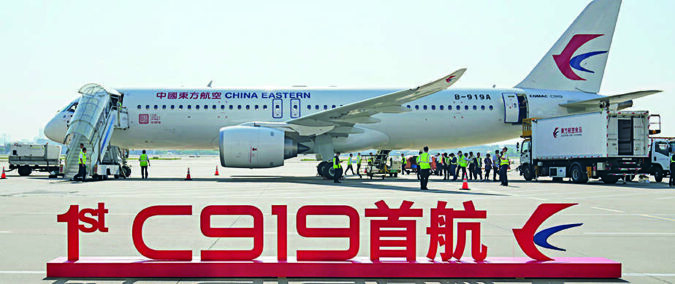Beijing: China’s first domestically made passenger jet flew its maiden commercial flight on Sunday, as China looks to compete with industry giants such as Boeing and Airbus in the global aircraft market.
The C919 plane, built by the Commercial Aviation Corporation of China (Comac), carried about 130 passengers on the flight, according to state-owned newspaper China Daily. The jet took off Sunday morning from Shanghai Hongqiao Airport and landed less than two hours later in Beijing. The flight was operated by state-owned China Eastern Airlines and the side of the plane was emblazoned with the words: “The World’s First C919.”
President Xi Jinping has hailed the project as a triumph of Chinese innovation, while on Sunday state media trumpeted the plane as a symbol of industrial prowess and national pride. “After generations of endeavour, we finally broke the West’s aviation monopoly and rid ourselves of the humiliation of ‘800 million shirts for one Boeing’,” Beijing Daily wrote, referring to the early years of economic reform around 40 years ago when China manufactured mainly low-value goods.
The inaugural flight comes as Comac looks to break into the single-aisle jet market in a direct challenge to the duopoly of Airbus and Boeing. Airbus’s A320 and Boeing’s B737 jets are the most popular aircraft typically used for domestic and regional flights. While Comac designed many of the C919’s parts, some of its key components are still sourced from the West, including engine and avionics.
The company plans to build 150 C919 planes each year for the next five years, according to earlier state media reports. The C919, which had been in development for 16 years, has a maximum range of about 5,630 kilometres and is designed to carry between 158 and 168 passengers. Over 1,200 C919 jetliners have been ordered, Comac says, with China Eastern Airlines under contract to buy five of them.
Li Hanming, an independent expert, said most C919 orders were letters of intent from domestic customers. The global market is questionable given that neither European nor US regulators have certificated the aircraft, said Greg Waldron, Asia managing editor of FlightGlobal publication. “Until this happens, key international markets will be closed to the C919″Agencies
The C919 plane, built by the Commercial Aviation Corporation of China (Comac), carried about 130 passengers on the flight, according to state-owned newspaper China Daily. The jet took off Sunday morning from Shanghai Hongqiao Airport and landed less than two hours later in Beijing. The flight was operated by state-owned China Eastern Airlines and the side of the plane was emblazoned with the words: “The World’s First C919.”
President Xi Jinping has hailed the project as a triumph of Chinese innovation, while on Sunday state media trumpeted the plane as a symbol of industrial prowess and national pride. “After generations of endeavour, we finally broke the West’s aviation monopoly and rid ourselves of the humiliation of ‘800 million shirts for one Boeing’,” Beijing Daily wrote, referring to the early years of economic reform around 40 years ago when China manufactured mainly low-value goods.
The inaugural flight comes as Comac looks to break into the single-aisle jet market in a direct challenge to the duopoly of Airbus and Boeing. Airbus’s A320 and Boeing’s B737 jets are the most popular aircraft typically used for domestic and regional flights. While Comac designed many of the C919’s parts, some of its key components are still sourced from the West, including engine and avionics.
The company plans to build 150 C919 planes each year for the next five years, according to earlier state media reports. The C919, which had been in development for 16 years, has a maximum range of about 5,630 kilometres and is designed to carry between 158 and 168 passengers. Over 1,200 C919 jetliners have been ordered, Comac says, with China Eastern Airlines under contract to buy five of them.
Li Hanming, an independent expert, said most C919 orders were letters of intent from domestic customers. The global market is questionable given that neither European nor US regulators have certificated the aircraft, said Greg Waldron, Asia managing editor of FlightGlobal publication. “Until this happens, key international markets will be closed to the C919″Agencies
